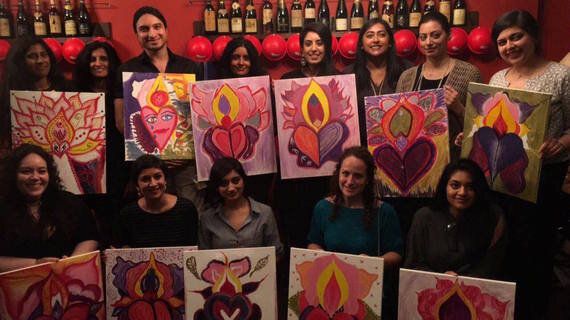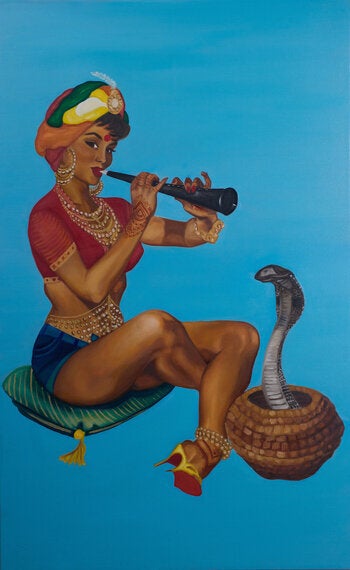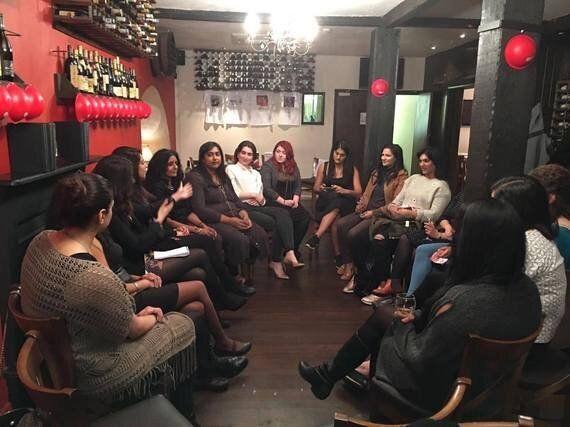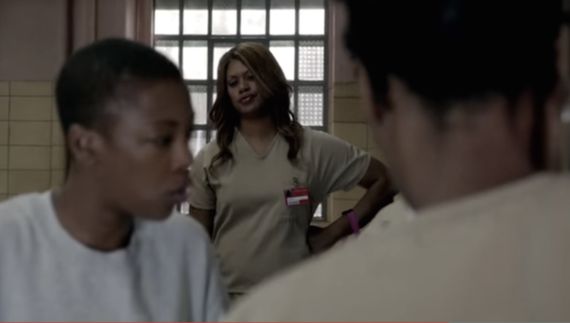
Image: Binti
To celebrate International Women's Day, The Edinburgh Collection Limited sponsored an art night with the Indo-Canadian aritist, Nimisha Bhanot, famous for her work that sexually liberates women of colour. Her work challenges what we expect from women in a patriarchal society, as her women hold your gaze, and make you think about why you are reacting to her art in that way.

Nagini (2015) Oil on canvas, 30x48 inches via www.nimishabhanot.com
The event itself was organised by Binti, a charity which promotes menstrual dignity through access to sanitary protection and education globally. The charity also works to #smashshame surrounding periods and menstruation. Something, which was brought up by Binti Ambassador Anila Dhami, as she introduced the evening:
"'They say a picture speaks a thousand words' which I think is the perfect saying for this evening as it is fundamentally about a word difficult to say and speak about. 'Menstruation' is a biological fact for many women around the world yet still has stigma attached to it. I didn't think I would ever be able to speak so openly about it. But it's a real problem - having a lack of sanitary towels or education around it. It's a cause I've now come to think and speak about greatly thanks to Binti.
Art is a form of expression and can be equally, or more, powerful than words. Art has the power to transform beliefs, inform thoughts, and inspire - not just ourselves as we pour ourselves on to paper, but also other in maybe thinking up an idea or inspiring them to act.
Henri Matisse says: 'creativity takes courage'. Nimisha is one woman who has been courageous and 'bold for change' - the theme for this year's International Women's Day. Nimisha is a contemporary Canadian artist whose work critiques the societal role and perception of South Asian women from a bi-cultural lens. Whether portraying badass brides or daughters-in-law, she juxtaposes cultural signifiers against sexually liberated composition to challenge patriarchal expectations of women.
For me, her paintings are seeing what is difficult to say. They are a challenge to look at because they fuse what is considered the societal 'norm' in our minds with what has stigma attached to it.
Tonight, we're all being bold together and joining Nimisha in smashing shame and stigma around menstruation. Let's be bold for change together - and have fun at the same time!"

Image: Binti
The evening started with mingling and getting to know fellow attendees, before moving on to the painting part of the evening for which Nimisha had chosen a task where participants used her painting as an example and guide.
Her painting, and the paintings for the night were inspired by the fabulous Georgia O' Keeffe who throughout her career denied furiously that her infamous flower paintings were in fact paintings of vulvas. Whether they were or not, they have been interpreted as such, and appropriated by feminism since the 1970s as being empowering.

Image: Binti
What was truly inspiring however was the way in which each artist used the theme to produce their own unique work, which was revealed during the critique of everyone's work after the painting session.
There were so many amazing responses to what it was that inspired their work but the three that stood out to me were Abbi's, Ahrabi's and Raj's.
Abbi discussed how her painting represented both pain and beauty:
"So I did the legs kind of purple/ blue to represent...bruising or pain, and then the...vagina is like a lotus and...a henna in style, so just something beautiful basically".
Ahrabi's beautiful painting also represented similar themes about how womanhood comes with both beauty and pain:
"I wanted this to represent the female form, I wanted to put a lot of decoration on it, but then the central point I focused on and couldn't wait to put on is actually this scar over here. Just to represent that...as women we decorate ourselves...we're beautiful, but we all have our scars, and I wanted this to represent that."
From a male perspective, Raj talked about what the two different sides of his painting represented, as one side was filled with dark colours, and the other sunshine and light:
He said that the dark side represented, "all the hurt and pain", that women go through. Whereas, the other side represents, "the happiness that women bring to all of us, they give birth to kings and queens".
If you want to see in full what each artist said about their work, the video from the night is available on Binti's Facebook page.

Image: Binti
The evening was profound in so many ways but what I think was significant is that it was vulvas that were being drawn. Everyone for example knows how to draw a penis. Yet, if you asked a lot of people on the street they'd hesitate when asked to draw the exact shape of a vulva. Why is this the case?
Manjit K. Gill, founder of Binti, commented that she, "never remembered seeing a vulva", when she was growing up being drawn. That is why she was so inspired by the way in which the painters, "described why they did what they did" (in the commentary). She was especially pleased by the way in which: "It was a safe and open place", in which to discuss vulvas and menstruation.
For me, having a place where women were forced to confront their vulva and what is actually going on 'down there', reminded me of the episode in Orange is the New Black in which a lot of the women in the prison did not realise that they have two separate holes, one for urinating (the urethra's opening is located between the clitoris and the vaginal opening) and one for everything else (the vaginal opening). This is because a women's sexual organ is never talked about in the same anatomical detail as a man's in my experience. I for one had heard of what balls were way before I heard about what the different bits of my own anatomy were (I am not talking about education from class, but 'playground talk' if you will).

Image: Orange is the New Black/ Netflix
Binti however wants it to be something that is talked about and will be holding events regularly to explore every facet of the vulva, including the biology, emotional, spiritual, cultural, and healthy aspects of vulvas, as well as talking about menstruation.
These events will all be part of Binti's mission to help #smashshame around menstruation. All around the world today there are still stigma's and taboos associated with periods that mean that menstruating becomes something that is simply not talked about. Binti's mission is to get people talking about periods, and replace the shame associated with periods with a message of empowerment. No matter who you are, you should not be ashamed of your body bleeding, when it is something that you cannot control. That means you shouldn't be afraid any longer to openly walk with your sanitary pad or tampon to the toilet to change it instead of tucking it under your sleeve, and you should not have to pay tax for tampons, or other sanitary products (sanitary products are not LUXURY products). Young women should not miss school because they cannot afford or get access to sanitary pads (whether it be in the UK or India) due to that no one talks about how they are necessary items. Binti believes that menstruation should in fact be a stand alone topic at schools because menstruation can start as young as 9 years old.
That is why the need to #smashshame is so important, as not talking abut menstruation affects the population in ways that people do not even realise or imagine. So talk about your period, talk about your vulva (and not just women, men too should let it be known that they are not afraid if these topics are brought up, and bring them up as well). And get painting, drawing, writing and creating too.
We can all #smashshame today.